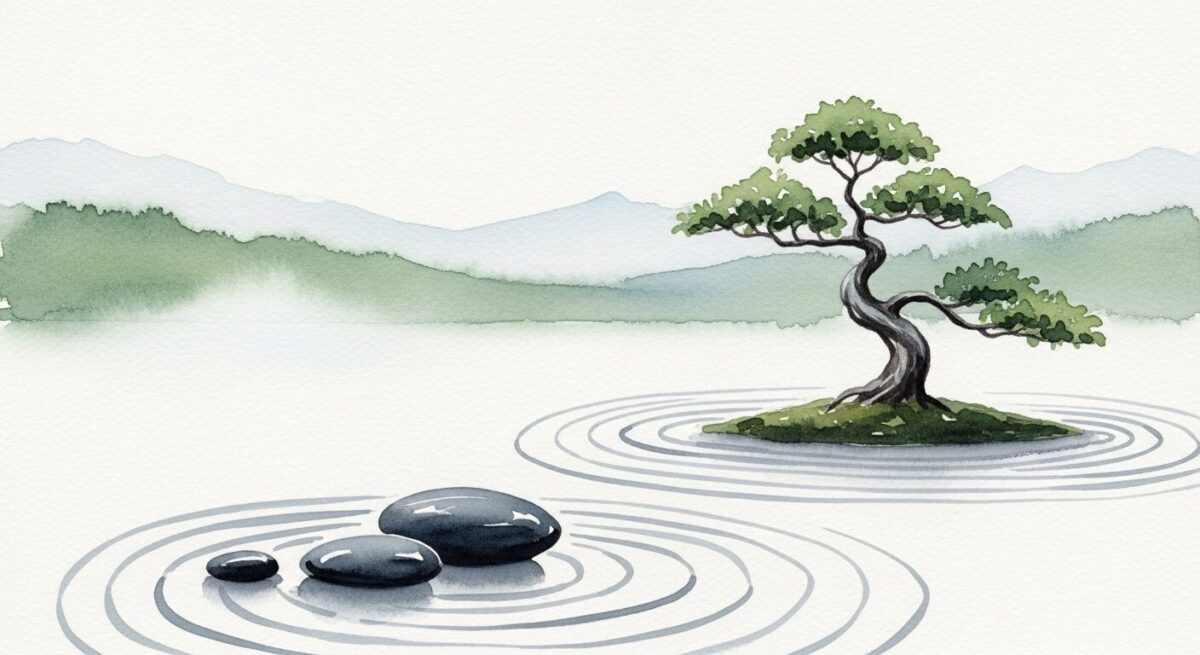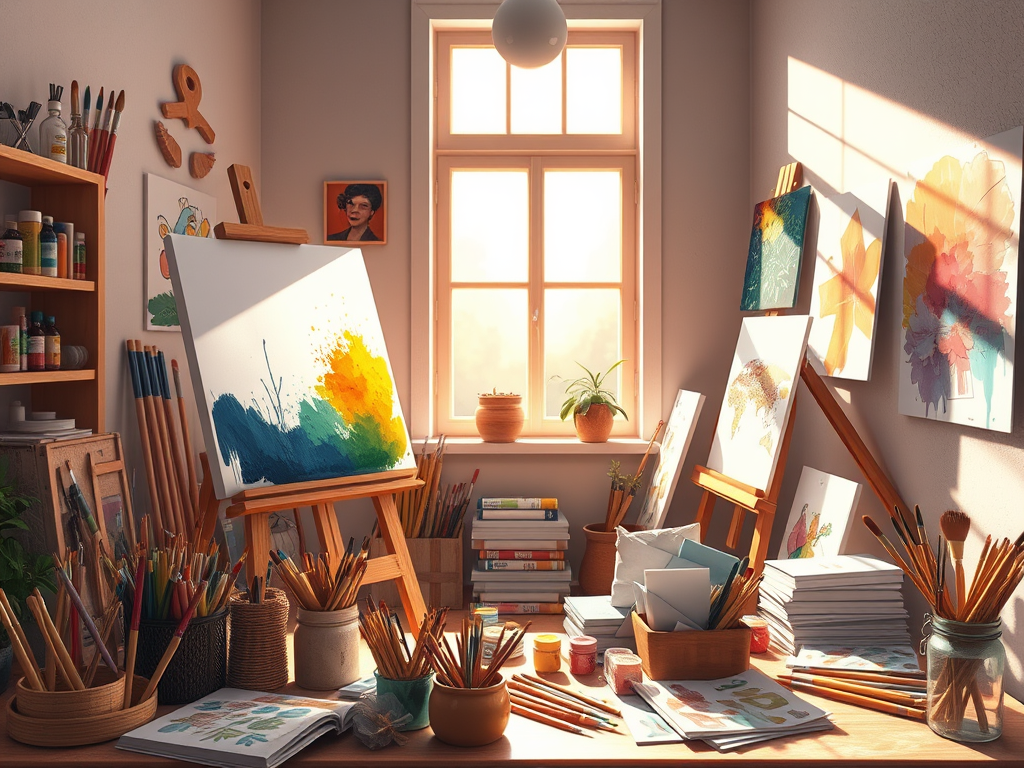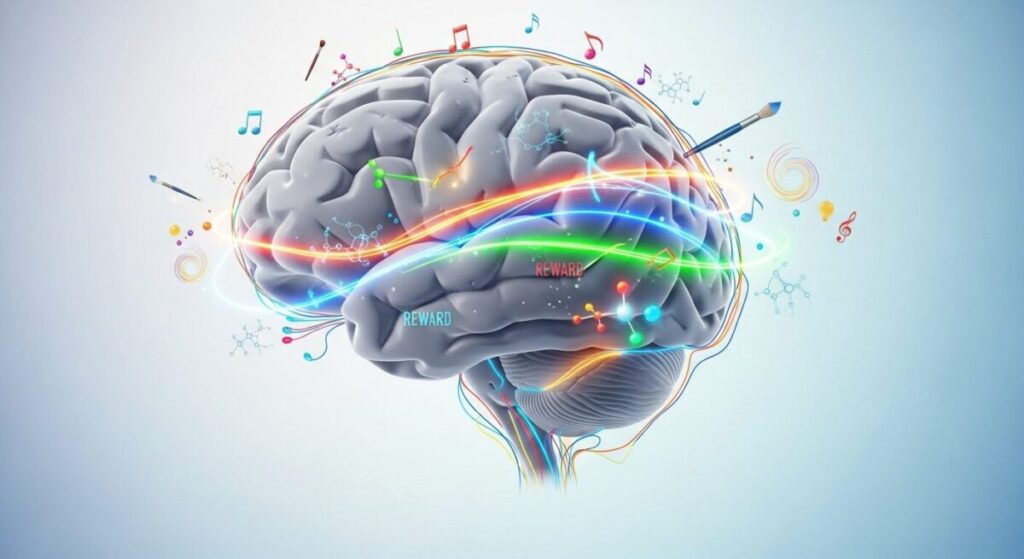Learn how watercolor mindful painting techniques can become your gateway to mindfulness, stress relief, and creative flow. This comprehensive guide covers essential techniques, supplies, and step-by-step methods for developing a zen painting practice.
What Is Zen Watercolor Art?
Zen watercolor art combines the fluid, unpredictable nature of watercolor painting with mindfulness principles to create a deeply relaxing and meditative practice. Unlike traditional painting focused on creating perfect representations, zen watercolor emphasizes the process over the product, encouraging artists to find peace in the present moment through brushwork.
This approach to watercolor painting offers unique benefits:
- Stress reduction through focused, meditative activity
- Improved mindfulness by requiring present-moment awareness
- Creative flow states that quiet mental chatter
- Acceptance of imperfection as colors blend naturally
- Sensory grounding through tactile and visual engagement
The medium’s inherent unpredictability makes it ideal for mindfulness practice, as artists must release control and embrace whatever emerges on the paper.
Essential Supplies for Zen Watercolor Practice
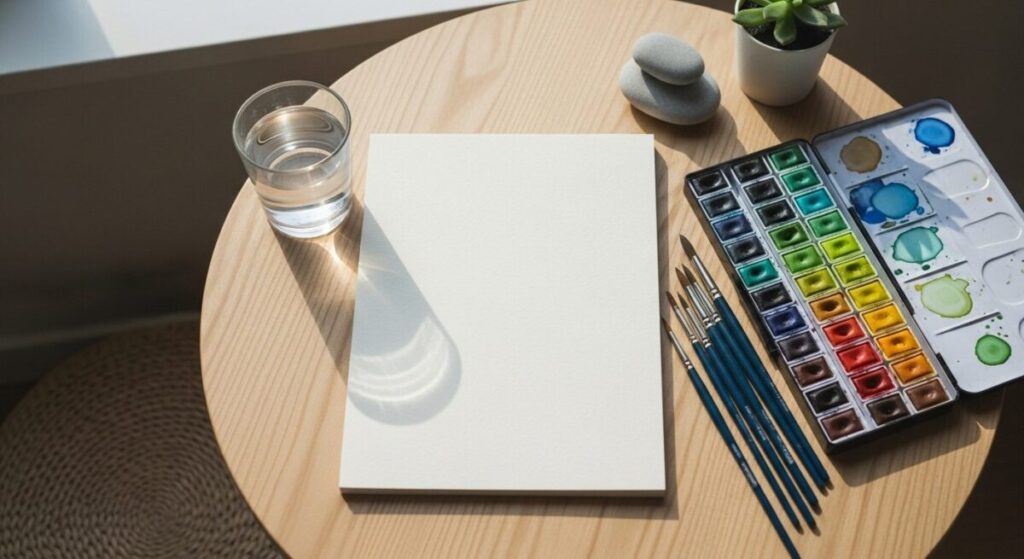
Basic Materials Needed:
- Watercolor paints: Start with 6-8 basic colors (ultramarine blue, burnt sienna, cadmium yellow, alizarin crimson, viridian green, burnt umber)
- Watercolor paper: 140lb cold-pressed paper minimum
- Brushes: Round brushes sizes 6, 10, and 14
- Water containers: Two jars (one for clean water, one for rinsing)
- Natural sponges: For texture and lifting techniques
- Paper towels: For blotting and controlling moisture
Creating Your Zen Space:
- Designate a quiet, well-lit area for practice
- Remove distractions (phones, clutter)
- Include calming elements (plants, soft music, essential oils)
- Ensure comfortable seating and proper table height
- Have all supplies within easy reach
Core Zen Watercolor Techniques
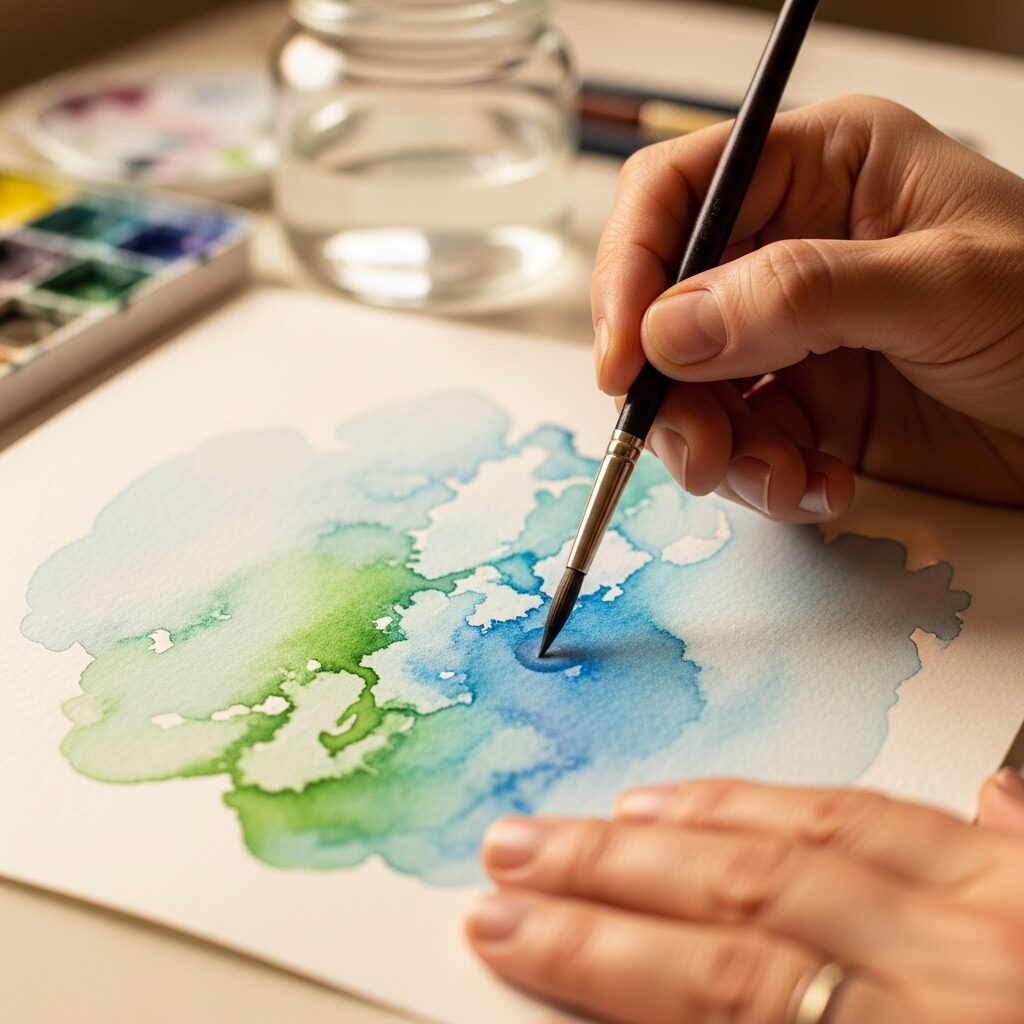
1. Wet-on-Wet Meditation
What it teaches: Surrender and acceptance of uncontrolled outcomes
Step-by-step process:
- Wet your paper evenly with clean water using a large brush
- While paper is still damp, drop 2-3 colors in different areas
- Tilt the paper gently to encourage natural color flow
- Observe without trying to control the blending
- Focus on your breathing as colors interact
- Notice any urge to intervene and simply observe it
Mindfulness focus: Watch colors spread with curiosity rather than judgment. Practice accepting whatever patterns emerge.
2. Gradient Wash Practice
What it teaches: Sustained attention and rhythmic breathing
Step-by-step process:
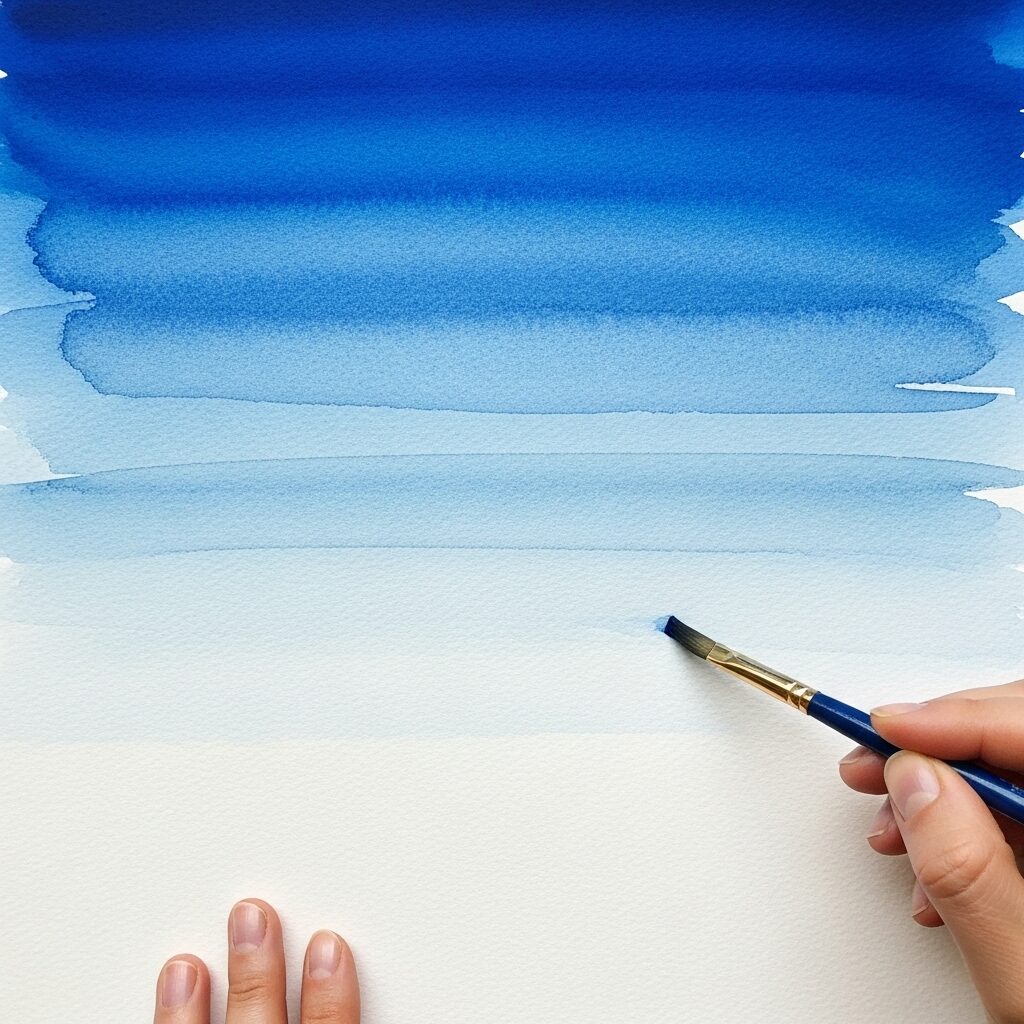
- Mix a puddle of color with plenty of water
- Load your brush fully and paint a horizontal stroke
- Clean brush, load with water, and paint overlapping stroke below
- Continue down the paper, gradually diluting the color
- Maintain steady rhythm: dip, paint, breathe, repeat
- Focus on the physical sensation of brush against paper
Mindfulness focus: Synchronize brushstrokes with natural breathing rhythm. Notice how sustained focus calms mental chatter.
3. Negative Space Awareness
What it teaches: Seeing emptiness as valuable, shifting perspective
Step-by-step process:
- Sketch simple shapes (leaves, flowers) very lightly
- Paint around the shapes, leaving them white
- Focus entirely on the spaces between objects
- Layer colors in background areas only
- Observe how unpainted areas define the composition
- Reflect on the importance of “empty” space
Mindfulness focus: Practice seeing what’s not there. Consider how emptiness in life (quiet moments, pauses) has value.
4. Dry Brush Texture Meditation
What it teaches: Micro-awareness and subtle attention
Step-by-Step process:
- Load brush with paint, then blot most moisture away
- Lightly drag brush across dry paper to create texture
- Vary pressure to create different effects
- Paint natural textures (tree bark, stone, fabric)
- Focus completely on pressure and brush angle
- Notice minute variations in each stroke
Mindfulness focus: Develop sensitivity to subtle changes in pressure, angle, and texture. This builds awareness of small details in daily life.
Developing Your Daily Practic
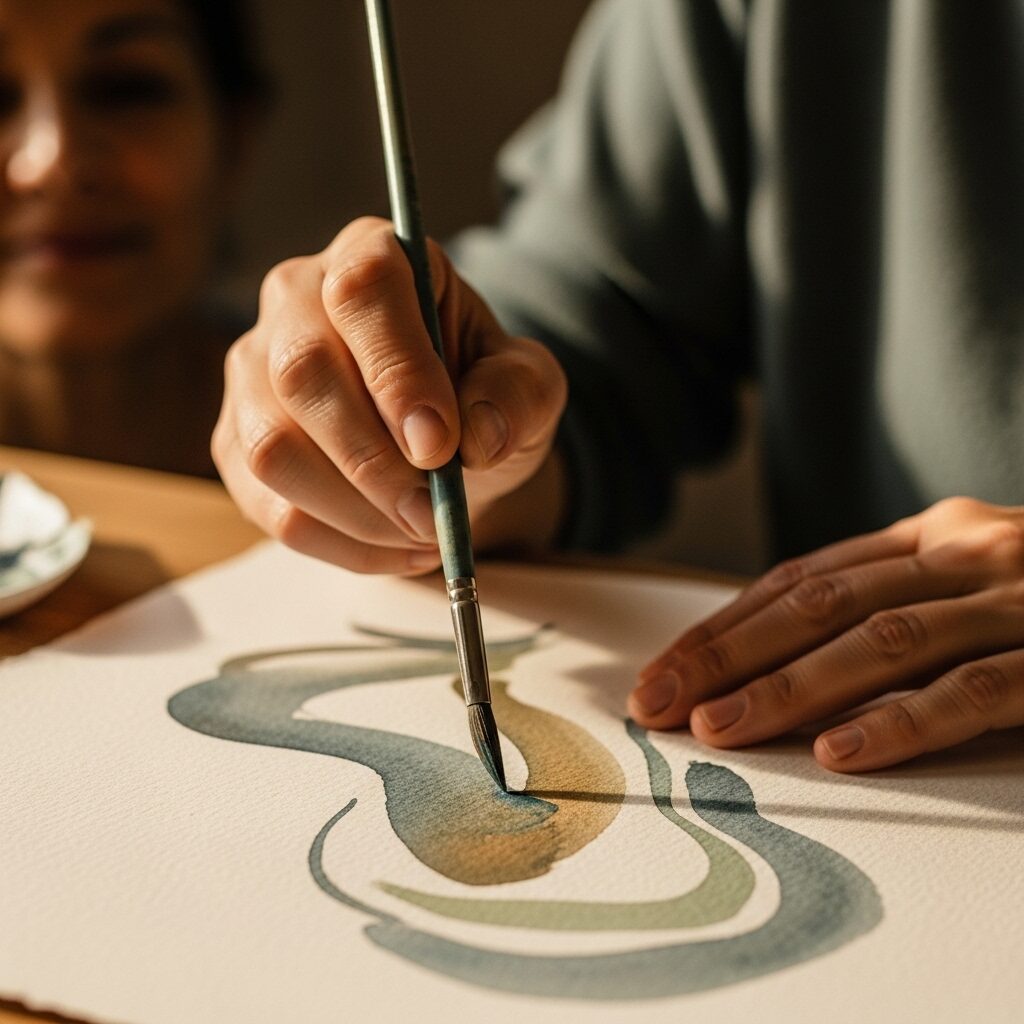
Morning Zen Watercolor Routine (10-15 minutes):
- Preparation (2 minutes): Set up supplies mindfully, take three deep breaths
- Warm-up wash (3 minutes): Create simple color blends without specific goals
- Technique focus (8 minutes): Practice one core technique with full attention
- Reflection (2 minutes): Observe your creation without judgment, note insights
Weekly Practice Structure:
- Monday: Wet-on-wet exploration
- Tuesday: Gradient washes
- Wednesday: Negative space studies
- Thursday: Texture meditation
- Friday: Free-form expression
- Weekend: Longer sessions combining techniques
Common Challenges and Solutions
“I’m Not Good at Art”
Solution: Remember that zen watercolor isn’t about creating masterpieces. Focus on the process and the feelings of calm it brings rather than the final result.
Colors Look Muddy
Solution: Use fewer colors per painting and ensure your water stays clean. Muddy colors often result from over-mixing or dirty water.
Feeling Frustrated with “Mistakes”
Solution: Reframe “mistakes” as opportunities to practice acceptance. Each unexpected outcome is a chance to let go of control.
Can’t Quiet Mental Chatter
Solution: This is normal. When thoughts arise, gently redirect attention to physical sensations: brush weight, water sounds, paper texture.
Advanced Mindful Techniques
Salt Texture Meditation
Sprinkle salt on wet paint and observe how it creates organic patterns. Practice patience as you wait for the effect to develop, resisting the urge to speed the process.
Lifting and Blotting Practice
Use sponges or paper towels to lift wet paint, creating clouds or highlights. Focus on the gentle pressure needed and the satisfaction of revealing white paper beneath color.
Color Breathing Exercise
Assign emotions or qualities to different colors. As you paint with each color, breathe in its associated quality (blue = calm, yellow = joy, green = growth).
Using Technology to Enhance Your Practice
While traditional mindfulness practices often emphasize disconnecting from technology, our Watercolor Art Generator tool demonstrates how digital resources can actually enhance—not detract from—your mindful creative practice when used intentionally. Rather than replacing the hands-on experience of painting, this tool serves as a digital muse, providing inspiration when you’re feeling stuck or offering a starting point for your own creations.
Watercolor Art Generator
Create beautiful watercolor paintings from text descriptions
The generator works by transforming descriptive text into watercolor-style imagery through AI-powered algorithms. But its true value for mindfulness practice lies not in the images themselves, but in the process of engaging with them. Begin by spending 5 minutes crafting a detailed description of the scene you’d like to paint—notice how this exercise in visualization already begins to calm your mind and focus your attention. When the image appears, don’t judge it as “good” or “bad,” but rather as a conversation starter between your imagination and the medium. What elements call to you? What would you change? How might you interpret this scene using actual watercolors?
This tool proves particularly valuable for overcoming the “blank page syndrome” that often blocks creative flow. When you’re feeling uninspired or overwhelmed by choices, generating an image provides a gentle nudge that preserves your creative autonomy while reducing decision fatigue. Try this exercise: generate an image, then set it aside. Attempt to recreate the feeling—not the exact image—using only three colors and focusing entirely on the physical sensations of painting. This practice bridges digital inspiration with analog mindfulness, using technology as a springboard to deeper presence rather than a distraction.
For those new to watercolor, the generator also helps visualize techniques before attempting them. Generate images with specific watercolor characteristics (“soft watercolor landscape with visible pigment granulation” or “abstract watercolor with salt texture effects”) to better understand what these techniques look like in practice. Then, experiment with creating similar effects yourself, observing the process with curiosity rather than judgment. This approach transforms the tool from a passive image source into an active learning companion that enhances your mindful engagement with the medium.
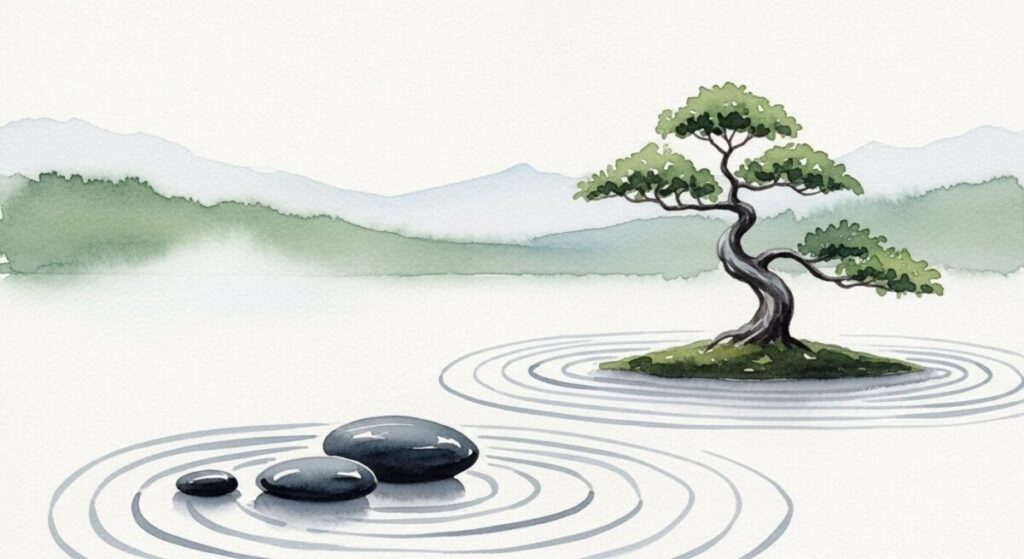
The Science Behind Watercolor Meditation
Research supports watercolor’s stress-reducing benefits:
- Cortisol reduction: Creative activities lower stress hormone levels
- Flow state activation: Watercolor’s balance of challenge and skill promotes deep focus
- Bilateral brain stimulation: Artistic creation engages both brain hemispheres
- Sensory integration: Multiple senses create grounding experience
Troubleshooting Your Practice
Paper Problems:
- Paper buckling: Use heavier weight paper (300lb) or stretch lighter paper
- Colors not flowing: Ensure paper is adequately wet for wet-on-wet techniques
- Paint beading: Paper may have sizing; try gentle scrubbing with clean water
Paint Issues:
- Colors too pale: Use less water in paint mixture
- Paint won’t stick: Paper may be too wet; wait for slight shine to disappear
- Harsh edges: Work faster while paint is still wet to maintain soft blends
Mental Blocks:
- Perfectionism: Create intentional “imperfect” paintings to practice acceptance
- Comparison: Focus on personal progress rather than comparing to others
- Impatience: Set timer for short sessions to build consistent practice habit
Building Long-Term Practice
Monthly Goals:
- Month 1: Establish daily routine, master basic techniques
- Month 2: Experiment with color combinations, develop personal style
- Month 3: Integrate breath work, extend session lengths
- Month 4: Explore advanced techniques, document insights
Tracking Progress:
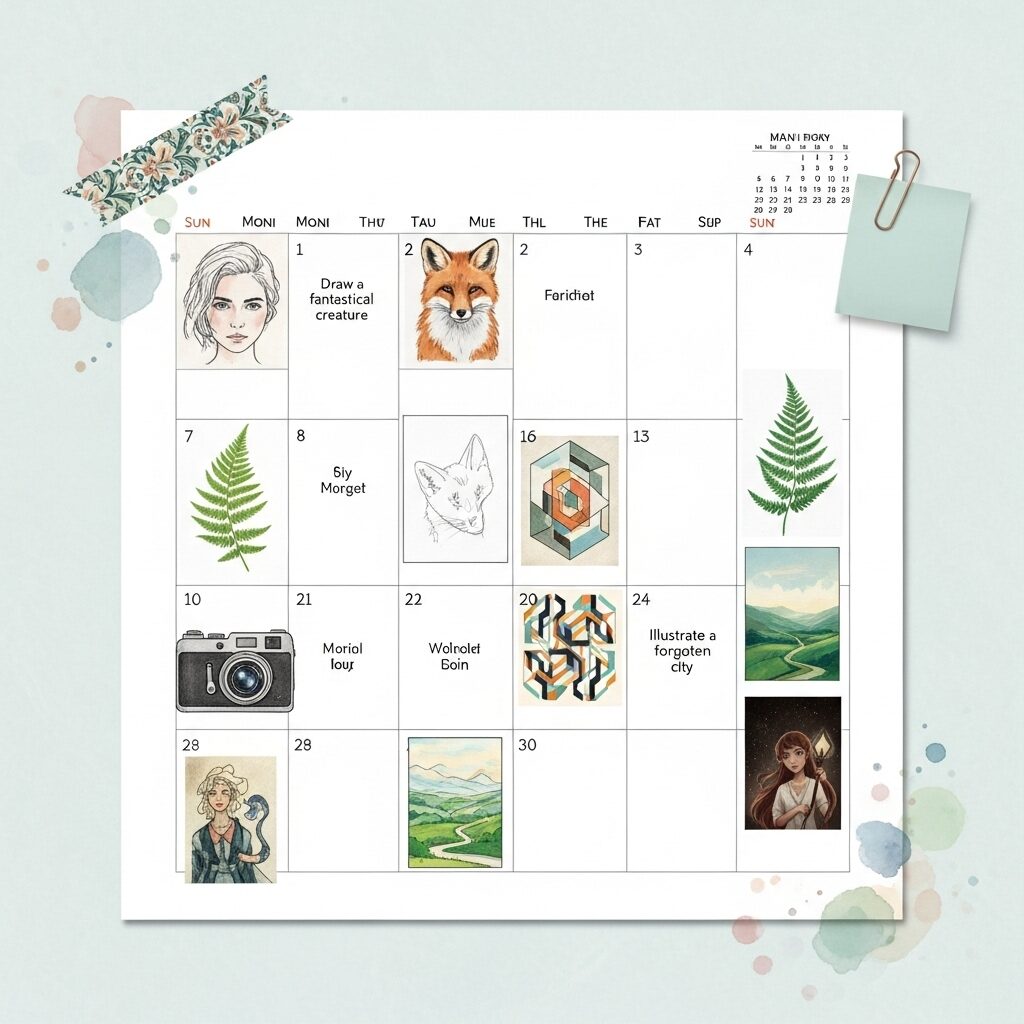
Keep a practice journal noting:
- Daily mood before and after painting
- Techniques practiced
- Insights or observations
- Breakthrough moments
- Challenges faced
Community and Sharing:
Consider joining local watercolor groups or online communities focused on mindful art practices. Sharing your journey (while maintaining focus on process over product) can provide motivation and support.
FAQs: Mindful Painting Techniques
Q: What is zen watercolor painting and how is it different from regular watercolor?
A: Zen watercolor painting emphasizes mindfulness and the meditative process over creating perfect artwork. While traditional watercolor focuses on technique and realistic representation, zen watercolor prioritizes present-moment awareness, acceptance of unpredictable outcomes, and using the painting process as a form of moving meditation. The goal is to become mindful of each brushstroke and enter a “flow” state where you’re in a meditative state, unaware of the passage of time.
Q: Can watercolor painting really help if I can’t meditate traditionally?
A: Absolutely! Many people find it difficult to quiet their minds through traditional meditation, and watercolor painting offers a simple and effective alternative that can help achieve a more meditative state. The physical engagement with brushes, water, and pigment provides a focal point that makes it easier to quiet mental chatter compared to sitting meditation.
Q: How long should I practice zen watercolor each day?
A: Start with just 10-15 minutes daily to establish a consistent habit. Even short 5-minute sessions can be beneficial for stress relief and mindfulness. As you become more comfortable, you can extend sessions to 20-30 minutes or longer. The key is consistency rather than duration—daily practice for shorter periods is more effective than occasional long sessions.
Q: What basic supplies do I need to start zen watercolor painting?
A: You need minimal supplies to begin:
- Watercolor paints: 6-8 basic colors (student grade is fine for beginners)
- Watercolor paper: 140lb cold-pressed paper minimum
- Brushes: 2-3 round brushes in different sizes (sizes 6, 10, 14)
- Water containers: Two jars (one clean, one for rinsing)
- Paper towels or sponges: For blotting and texture
- Simple workspace: A quiet area with good lighting
Q: Do I need artistic experience to practice zen watercolor?
A: No artistic experience is necessary! Zen watercolor is about the meditative process, not creating museum-quality art. In fact, being a beginner can be advantageous because you’re less likely to have preconceived notions about how things “should” look. The practice teaches acceptance of imperfection and embraces “happy accidents.”
Q: What’s the difference between zen watercolor and art therapy?
A: While both use art for well-being, zen watercolor focuses specifically on mindfulness and present-moment awareness through the painting process. Art therapy involves working with a trained therapist to address specific psychological issues through creative expression. Zen watercolor is a self-directed mindfulness practice that anyone can do for stress relief and meditation.
Q: How do I know if I’m doing zen watercolor “correctly”?
A: There’s no “wrong” way to practice zen watercolor! Signs of effective practice include:
- Feeling more relaxed during and after painting
- Noticing your breathing naturally slow down
- Losing track of time while painting
- Feeling less attached to specific outcomes
- Increased acceptance of “imperfections” in your art and life
Q: Can children practice zen watercolor?
A: Yes! Children often naturally approach art with the mindful, process-focused attitude that zen watercolor encourages. For kids, focus on:
- Shorter sessions (5-10 minutes)
- Emphasizing the fun of color mixing
- Celebrating all outcomes as “perfect”
- Using watercolor as a calming activity before bedtime or after stressful situations
Q: What should I do when colors turn muddy or “mistakes” happen?
A: In zen watercolor, there are no mistakes—only opportunities to practice acceptance! Muddy colors and unexpected outcomes are part of the learning process. Instead of getting frustrated:
- Observe your emotional reaction without judgment
- Ask yourself what the “mistake” might teach you
- Consider how the unexpected result might be beautiful in its own way
- Use it as a reminder to let go of perfectionist tendencies
Q: How is using a Watercolor Art Generator different from traditional zen painting?
A: The Watercolor Art Generator serves as a digital inspiration tool rather than a replacement for hands-on practice. It helps overcome creative blocks by providing visual starting points, but the actual zen benefits come from the physical process of painting with real watercolors. The generator is most effective when used to spark ideas that you then explore through traditional painting, maintaining the mindful, tactile experience.
Q: Can zen watercolor help with anxiety and stress?
A: Yes, research supports watercolor’s stress-reducing benefits. The practice naturally lowers cortisol (stress hormone) levels while increasing production of dopamine and serotonin (feel-good chemicals). The combination of focused attention, rhythmic brushwork, and sensory engagement creates a powerful antidote to anxiety and stress.
Q: What’s the best time of day to practice zen watercolor?
A: The best time is whenever you can practice consistently without distraction. Many people find:
- Morning: Helps set a calm, focused tone for the day
- Evening: Provides transition from work stress to relaxation
- Lunch breaks: Offers midday mental reset
- After stressful events: Serves as immediate stress relief
Q: How do I create a zen watercolor practice space at home?
A: Your space doesn’t need to be large or elaborate:
- Choose a quiet corner with good natural lighting
- Keep supplies organized and easily accessible
- Include calming elements (plants, stones, soft music)
- Ensure comfortable seating and proper table height
- Remove distractions (phones, clutter, stressful reminders)
- Consider designating this space solely for your practice
Conclusion
Watercolor painting offers a uniquely accessible path to mindfulness that combines sensory engagement, creative expression, and the profound lesson of embracing uncertainty. In a world that constantly demands control and predictability, the fluid nature of watercolor teaches us to find beauty in the unexpected and peace in the present moment. Each brushstroke becomes a meditation, each color blend a reminder to release our grip on perfection, and each painting session an opportunity to reconnect with our innate creativity.
Our Watercolor Art Generator serves not as a replacement for this hands-on practice, but as a digital companion that lowers barriers to entry and provides inspiration when needed. Whether you’re an experienced artist or someone who hasn’t picked up a paintbrush since childhood, the mindful practice of watercolor invites you to slow down, breathe deeply, and rediscover the joy of creating without judgment.
The journey toward mindful watercolor practice isn’t about creating gallery-worthy pieces—it’s about cultivating presence with each stroke, finding stillness within movement, and reconnecting with the simple pleasure of making. As you incorporate these techniques into your routine, you may find that the calm and focus developed at your painting station naturally extend into other areas of your life. So gather your supplies, take a deep breath, and let the water flow—your journey to creative mindfulness begins with a single drop of color on paper.

